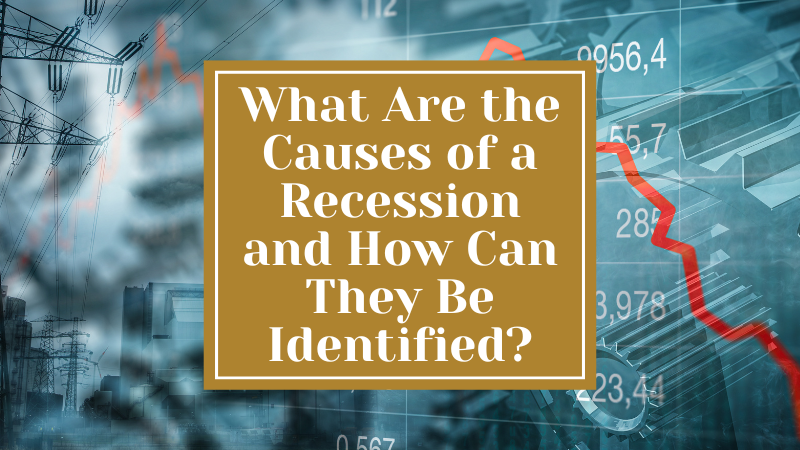Have you ever wondered what sparks these economic downturns and how experts unveil their impending arrival?
Join us on an enlightening journey as we uncover the enigmatic causes behind recessions and unravel the secrets of their identification. From economic imbalances to financial crises and beyond, this captivating article will shed light on the hidden forces that shape our financial landscapes.
So fasten your seatbelt and get ready to decode the signs that foretell the rise and fall of economies. Welcome to the intriguing exploration of recessions and their secrets!
Common Causes of Recessions
A recession is typically caused by a combination of various economic factors. While each recession may have its unique triggers, some common causes include:
- Tight monetary policy: When central banks raise interest rates to control inflation, it can lead to reduced borrowing and spending by businesses and consumers, which can slow down economic activity and contribute to a recession.
- Economic imbalances: Imbalances in the economy, such as excessive borrowing, unsustainable asset price growth, or over-investment in certain sectors, can create vulnerabilities that eventually lead to a downturn.
- Financial crises: Financial crises, such as the subprime mortgage crisis in 2008, can trigger recessions. Sharp declines in housing markets or disruptions in the banking and financial sectors can have a ripple effect throughout the economy, causing a contraction in economic activity.
- External shocks: External events, such as natural disasters, geopolitical conflicts, or global economic downturns, can significantly impact economies, leading to recessions. These shocks can disrupt supply chains, reduce consumer and investor confidence, and negatively affect business operations.
- A decline in consumer and business spending: During a recession, consumers and businesses tend to cut back on spending due to factors like job losses, income uncertainty, or pessimism about the economic outlook. This decline in spending can lead to reduced demand and economic contraction.
More Specific Indicators Used to Identify the Cause of a Recession
Identifying the causes of a recession can be challenging, as it often requires careful analysis of economic data and trends. Economists and policymakers monitor various indicators to assess the health of the economy and identify potential recessionary signals. Some key indicators include:
- GDP growth: Significant declines in the Gross Domestic Product (GDP), which measures the total value of goods and services produced within a country, can be an indication of an economic downturn.
- Employment data: Rising unemployment rates, job losses, or declines in labor force participation can signal economic weakness and potential recessionary conditions.
- Consumer spending: Reduced consumer spending, as reflected in retail sales figures and consumer confidence surveys, can point to a slowdown in economic activity.
- Business investment: Decreased business investment, such as declines in capital expenditures or reduced business confidence, may suggest a contraction in economic growth.
- Financial market indicators: Volatility in financial markets, declining stock prices, widening credit spreads, or disruptions in the banking sector can be warning signs of economic distress.
- Leading economic indicators: Economists often monitor leading indicators that provide insights into the future direction of the economy. These indicators can include measures such as stock market performance, consumer sentiment surveys, business surveys (e.g., Purchasing Managers’ Index), and housing market data.
- Yield curve inversion: The yield curve, which shows the relationship between short-term and long-term interest rates, can provide clues about future economic conditions. When the yield curve inverts (i.e., when long-term interest rates fall below short-term rates), it has historically been a reliable predictor of an impending recession.
- Manufacturing and industrial production: Declines in manufacturing output, industrial production, or factory orders can indicate a slowdown in economic activity and potentially signal a recession.
- Business and consumer sentiment: Surveys that assess the sentiment of businesses and consumers can reveal their expectations and confidence about the economy. Significant declines in confidence indicators may suggest a deteriorating economic outlook.
- Real estate market indicators: Real estate indicators, such as housing starts, building permits, or home sales, can provide insights into the health of the housing sector, which is closely linked to the overall economy. Sluggish real estate activity may indicate a weakening economy.
- Financial stress indicators: Measures of financial stress, such as credit default swaps, interbank lending rates, or corporate bond spreads, can reflect the health of the financial system. Sharp increases in these indicators may signal heightened risk and potential economic turbulence.
- Unemployment claims: Monitoring the number of unemployment claims filed can provide insights into the labor market and economic conditions. A significant increase in unemployment claims can be a sign of economic weakness.
- Business profitability: Declines in corporate profits or profit margins can suggest a weakening economy. Lower profits may lead to reduced investment, hiring, and overall economic activity.
- Inventory levels: Excess inventory levels can indicate weak demand and an imbalance between supply and consumption. If businesses accumulate excess inventory, it may signal a slowdown in economic activity.
- Consumer credit and debt levels: Rising consumer debt and increased delinquency rates can indicate financial stress and potential economic challenges. High levels of consumer debt can lead to reduced spending and slower economic growth.
- Trade indicators: International trade data, such as exports and imports, can provide insights into global economic conditions and potential impacts on domestic growth. A significant decline in trade can signal an economic slowdown.
- Government policy and fiscal stimulus: Changes in government policies, including fiscal stimulus or austerity measures, can influence economic conditions. Examining government spending, taxation policies, and stimulus measures can help assess the impact on the economy.
- Academic research and economic models: Economists and researchers continuously study economic data and develop models to identify recessionary patterns. These models consider various economic variables and historical trends to estimate the likelihood of a recession.
- International economic conditions: Global economic trends and conditions can impact individual economies. Monitoring indicators such as global GDP growth, trade patterns, and financial market volatility can provide insights into the potential risks of a recession.
- Composite indicators: Some organizations create composite indicators that combine multiple economic variables to generate an overall measure of economic health. These composite indicators aim to provide a holistic view of the economy and its trajectory.
- Consumer price inflation: Monitoring changes in consumer prices can provide insights into inflationary pressures and overall economic conditions. If inflation slows down significantly or turns into deflation (negative inflation), it can signal weak demand and a struggling economy.
- Capacity utilization: Capacity utilization measures the extent to which businesses are utilizing their productive capacity. Declining capacity utilization rates can indicate reduced economic activity and potential recessionary conditions.
- Business bankruptcies: An increase in business bankruptcies can be a sign of financial distress and economic difficulties. Monitoring bankruptcy filings can provide insights into the health of the business sector and the overall economy.
- Monetary policy actions: Monitoring the actions and statements of central banks can provide clues about their assessment of the economy. Central banks may lower interest rates, implement quantitative easing measures, or adjust monetary policy in response to a weakening economy.
- Consumer and business surveys: Surveys conducted by organizations and research institutions can provide valuable insights into consumer and business sentiment. Monitoring surveys that assess future expectations, investment plans, or consumer spending intentions can help gauge economic conditions.
- Regional economic indicators: Examining regional economic data, such as employment rates, housing prices, or business activity, can help identify localized economic downturns that may precede a broader recession.
- Leading indexes and economic forecasting models: Various organizations develop leading economic indexes or forecasting models that incorporate multiple economic indicators. These tools aim to predict future economic conditions and potential recessions based on historical relationships and statistical analysis.
- Government reports and economic data releases: Official government reports, including GDP growth figures, employment reports, retail sales data, and industrial production numbers, provide valuable information about the state of the economy. Monitoring these reports can help identify trends and potential recessionary signals.
- Academic and research publications: Economic research papers, articles, and publications from reputable institutions often delve into recession analysis, provide insights into the drivers of economic downturns, and present new methodologies for identifying recessions.
- Consultation with economists and experts: Seeking the expertise of professional economists and financial analysts can provide valuable insights and interpretations of economic data. Economists specializing in macroeconomics and forecasting can offer informed perspectives on the likelihood and timing of a recession.
- Stock market performance: Monitoring stock market indices can provide insights into investor sentiment and expectations about the economy. Significant declines in stock prices may indicate concerns about future economic prospects.
- Business investment and capital expenditure: A slowdown in business investment and capital expenditure can be a sign of caution and reduced economic activity. Monitoring business spending on equipment, facilities, and research and development can provide insights into future economic conditions.
- Financial market indicators: Beyond stock market performance, other financial market indicators such as bond yields, credit spreads, currency exchange rates, and commodity prices can provide signals about investor sentiment and economic expectations.
- Employment trends by sector: Analyzing employment trends across different sectors can help identify areas of weakness or strength in the labor market. Job losses or significant declines in specific sectors may indicate broader economic challenges.
- Government fiscal indicators: Monitoring government revenue, expenditures, and budget deficits can provide insights into the fiscal health of a country. Significant fiscal imbalances or austerity measures can impact economic growth and contribute to a recession.
- Real-time data and high-frequency indicators: In recent years, economists have increasingly turned to real-time data and high-frequency indicators, such as credit card transactions, online search trends, and social media sentiment analysis, to gain more timely insights into economic conditions and potential recessions.
- Historical patterns and economic cycles: Examining historical patterns and economic cycles can offer insights into the likelihood and duration of recessions. By studying the historical relationship between various indicators and past recessions, economists can develop models and frameworks for recession prediction.
Remember that no single indicator or method can guarantee accurate predictions of a recession. Economies are complex, and the interplay of various factors makes forecasting challenging. It’s important to consider a combination of indicators, conduct a thorough analysis, and seek diverse perspectives when assessing the potential for a recession.
What Are the Causes of the Current Recession
At the time of writing this article, the United States is not currently in a recession, although many suspect that could change in upcoming months. The last major recession in the United States was called the Great Recession and lasted for an 18-month period between December 2007 and June 2009.
Recently, the coronavirus pandemic created a recession that is recorded to have lasted only two months, from March 2020 through April 2020.
As you read through these indicators did you notice many factors that could currently be leading us to another recession in 2023? Many industry experts believe so and many people are predicting that another recession is right around the corner.
However, the questions remain about how long the next recession might last and how severe will the next recession be. Some people believe it will be a gentle recession with a soft landing and be over relatively quickly while others believe we are heading for another great recession situation.
Regardless of the severity of the potential next recession, it’s important to remember that recessions always end eventually and that many of the people hit hard by the Great Recession have since recovered and are better off now than the were before the Great Recession.
Start thinking now about ways you could manage costs and increase your personal savings to help you weather a potential recession.
Final Thoughts on the Causes and Identifiers of a Recession
As we conclude our exploration of recessions and their elusive nature, we have unraveled a complex web of interconnected factors that can trigger these economic storms. From imbalances in financial markets to global economic shocks, recessions emerge from a delicate interplay of forces that can impact societies at large.
However, armed with knowledge and the ability to identify key indicators, we can better navigate the economic landscape. By monitoring leading indicators, studying historical patterns, and leveraging expert analysis, we can enhance our understanding of recessions and potentially mitigate their impacts.
Remember, recessions are not invincible adversaries but rather puzzles to be solved and lessons to be learned. So, as we brace ourselves for the uncertainties of the future, let us remain vigilant, adaptable, and proactive in our pursuit of economic stability. Together, we can strive to build resilient economies that weather the storms and emerge stronger on the other side.
Do you think we’re headed for a recession? Share your thoughts with us in the comments below.




